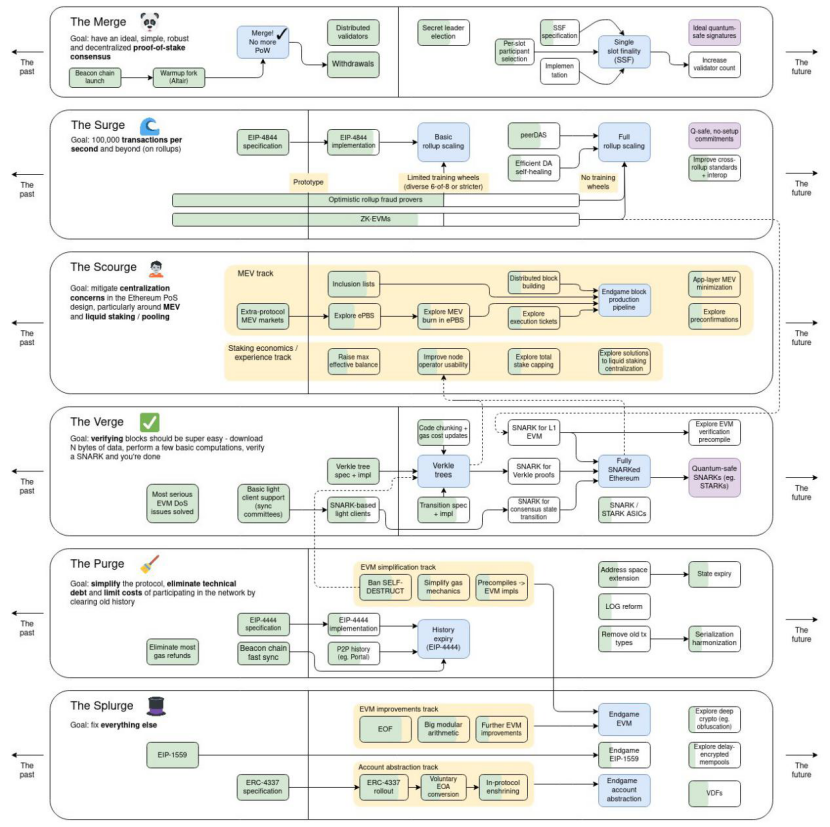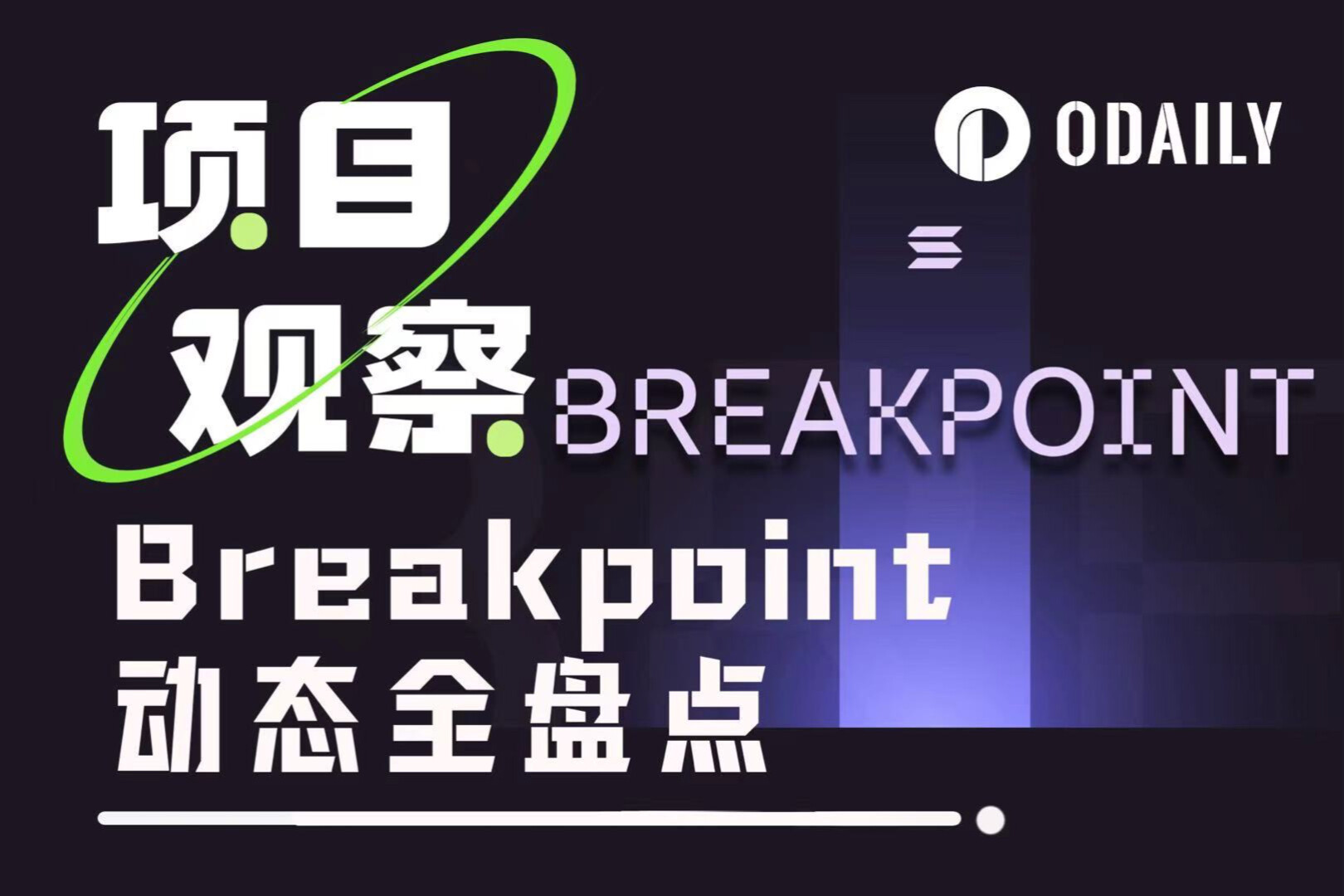Ethereum 2024 Roadmap Update and EIP Improvement Proposal Preview
Ethereum roadmap update
On December 30, 2023, Ethereum co-founder Vitalik Buterin shared the 2024 Ethereum roadmap on the X social network and detailed the upgrades and activities of the Ethereum network. According to a series of charts he laid out, continued concerns for Ethereum in 2024 include 6 major components: The Merge, The Surge, The Scourge, The Verge, The Purge, and The Splurge.

(1) The Merge is highlighted as a key part of the roadmap aimed at maintaining a simple and resilient POS consensus mechanism. It takes place in September 2022 and merges the Ethereum mainnet with the POS beacon chain. Since the merge, single-slot finality (SSF) roles will be prioritized. SSF allows Ethereum’s consensus mechanism to validate blocks more efficiently, allowing blocks to be proposed and finalized in the same slot, thereby reducing transaction latency. After Ethereum transitions from POW to POS consensus mechanism, Single Slot Finality (SSF) will serve as a key solution to Ethereum’s current weaknesses.
(2) The Surge aims to achieve a throughput of 100,000 transactions per second in the Ethereum and L2 networks while improving the scalability of the blockchain. The cross-rollup standard and interop have been highlighted as areas for long-term improvement by the Ethereum development team, and this year will see significant progress in EIP-4844 and the scalability of rollups themselves.
(3) The Scourge focuses on mitigating risks related to Maximum Extractable Value (MEV), liquidity staking pools, and rollups to address concerns about economic centralization within the Ethereum ecosystem. Vitalik Buterin had earlier suggested reducing the cost of running nodes to address related challenges. Now that the Verkle tree is ready, validating a block will simply involve downloading a few bytes of data, performing some basic calculations, and verifying a succinct, non-interactive argument of knowledge (SNARK). The network will continue to explore Ethereum Virtual Machine (EVM) verification precompilation to achieve a fully SNARK-ified Ethereum network.
(4) The Verge aims to make block verification easier and improve the efficiency of block verification. This optimization is critical to maintaining Ethereum’s scalability as on-chain transaction volume continues to grow. The roadmap removes the content of increasing the L1 gas limit so that the gas limit can be increased at any time, indicating a flexible method of network capacity management.
(5) The Purge aims to make the protocol easier to use, making it more developer-friendly and accessible. This simplification will eliminate technical debt and limit network participation costs, expected to improve the overall functionality and usability of the Ethereum network.
(6) The Splurge covers all other elements critical to Ethereum’s growth, from ecosystem growth and sustainability to human coordination, reflecting Ethereum’s commitment to nurturing and supporting its vibrant community. promise.
EIP Improvement Proposal Preview
Ethereum will usher in the Dencun hard fork upgrade in the first quarter of 2024, and Ethereum core developers have drawn up a Dencun hard fork upgrade schedule. As long as no major problems occur, Ethereums public test network will tentatively proceed according to the following schedule:
Goerli: January 17
Sepolia: January 30
Holesky: February 7
This will be the last time Goerli is included in a test scenario as the network is about to be deprecated. The move is part of Dencun’s strategy to activate on the Ethereum network in January 2024 and marks a significant advancement in its technical capabilities.
Core developers also discussed a yet-to-be-named Prague/Electra upgrade. The Ethereum community is considering whether to focus on large core features (which may take a year of effort), or to build upgrades around multiple smaller improvements (which could be achieved in the second half of 2024).
Overall, 2024 will be the year when Ethereum implements groundbreaking improvement proposals. Here are some improvement proposals worth paying attention to:
(1)EIP-4844 (Proto-Danksharding)
EIP-484 is the highlight of the many proposals for Dencun upgrade and the proposal that attracts the most attention in the market. Its main purpose is to reduce gas costs on the L2 network without sacrificing decentralization, especially for rollup solutions.
The Dencun upgrade will reduce all L2 costs in terms of data availability, which is something the market is looking forward to because end-user costs will be further reduced. EIP-4844 is a transformative enhancement proposal expected to reduce rollup gas costs by 100x.
(2) ERC-4337, ERC-6900 (account abstraction)
Account abstraction is also a very important improvement proposal, including ERC-4337 and its extension proposal ERC-6900. Account abstraction, centered on the concept of smart accounts, has a significant impact on the end-user experience and will reduce transaction costs and ensure social login security. ERC is a subset of EIP that specifically targets token standards in the Ethereum ecosystem. It defines rules for token execution to ensure interoperability. Unlike EIPs, which modify the core protocol, ERC typically does not require a hard fork.
ERC-4337 will take place in March this year, and the concept of account abstraction will bring important changes and a critical role for end users. Account abstraction will revolutionize how users perceive and interact with crypto wallets, making gas-free transactions the standard while making secure social login the new norm, fundamentally reshaping the Ethereum user experience.
Traditionally, Ethereum has two account types: external accounts (EOA) controlled by private keys and contract accounts controlled by code. Account abstraction blurs this distinction, allowing users to create accounts that function more like smart contracts. It enhances user experience and security and allows for more complex account logic, such as multi-signature wallets or social recovery of lost keys.
ERC-6900 proposes the concept of delegated transactions. The standard does not require changes to Ethereums mainnet consensus, and it allows users to delegate delegates to send transactions and, for example, approve a set of operations to save time and hassle.
(3) EIP-1153 (Instant storage opcode)
EIP-1153 is part of the Dencun upgrade that aims to introduce a new mechanism for handling temporary or temporary storage during smart contract execution. Ethereums traditional storage operations are permanent and consume gas, which may be ineffective for temporary data that does not need to last longer than a transaction. EIP-1153 is an opcode that will allow smart contracts to use transient storage, i.e. the storage will be cleared at the end of transaction execution.
The Uniswap team lobbied hard for EIP-1153 and wanted it implemented in the Shanghai upgrade, but failed to gain enough support to reach consensus among Ethereum core developers. The upgrade is expected to play an important role in improving the capabilities and efficiency of the Uniswap V4 protocol.
By enabling temporary storage, EIP-1153 can reduce the gas costs associated with storing data during contract execution and provide developers with greater flexibility in designing smart contracts. EIP-1153 also contributes to the overall scalability of the Ethereum network by offloading permanent storage and minimizing state bloat.
(4) EIP-4788 (Beacon block root submission)
Ethereum is like a huge library, which contains two main parts: the first part is the Ethereum Virtual Machine (EVM), which allows people to read books (execute smart contracts) like a reading room; the second part is the beacon chain , like a library catalog system that tracks all books and their locations (consensus and coordination on the Ethereum network).
Prior to EIP-4788, these two parts operated relatively independently. The EVM cannot directly access the latest directory, it must rely on indirect methods to understand what is happening in the beacon chain. And EIP-4788 proposes to put the beacon block root (the digest or the hash tree root of the parent block) into every EVM block. This would be the equivalent of moving an outdated card filing system in a library, which was inefficient and inaccurate, to a system with real-time, accurate and direct links to the main database.
In Ethereum, a modern library system, readers (EVM) can get instant updated information every time a book is added, moved, or deleted (beacon chain update). Patrons can trust access to the most up-to-date information, and library operations (such as executing smart contracts) are more consistent with the overall catalog system (the state of the consensus layer).
The above process all happens in a way that minimizes the need for trust, eliminating the need for external oracles to provide this data, thereby reducing potential points of failure or manipulation. EIP-4788 introduces protocol-level oracles to communicate the consensus state of Ethereum throughout the mainnet. This change is particularly beneficial for liquidity staking protocols, such as Lido, as well as smart contract-based bridges and re-staking solutions, as it allows these protocols to access key data such as validator balances and status directly from the consensus layer, thereby improving their safety and operational efficiency.
(5) EIP-5656 (MCOPY operation code)
The EVM operates using a set of opcodes that determine various operations. EIP-5656 introduces a new opcode called MCOPY that optimizes the process of copying data in memory during smart contract execution.
Copying large data segments is inefficient when using existing opcodes in the current EVM architecture. MCOPY provides a more efficient approach that is expected to reduce the gas fees associated with these operations while improving performance. Faster memory operations mean faster contract execution and developers will have more tools to optimize their smart contracts, especially when dealing with large data structures or complex operations involving memory operations.
(6) EIP-6780 (restricted self-destruction)
In the Ethereum blockchain, the self-destruct opcode allows a smart contract to delete itself from the blockchain. After execution, it will delete the storage space of the contract code and status, and send the remaining ETH of the contract to the specified address. However, this feature leads to several issues, including state management complexity and potential security vulnerabilities.
By limiting self-destruction, Ethereum can better manage its state size, making the blockchain more stable and predictable. This is critical for the long-term scalability and maintenance of the network as it will simplify future Ethereum upgrades.
Taken together, the Ethereum 2024 roadmap updates and important EIP proposals demonstrate the Ethereum blockchain’s adaptability to industry changes and clearly demonstrate a clear vision for robust operation while improving scalability. It is foreseeable that 2024 will be an important year for Ethereum to continue to explore innovation and technological upgrades and improvements.



